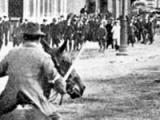At 7.20 a.m. an explosion at Ralph's mine on Raynor Rd rocked Huntly. It was caused by a miner's naked acetylene cap-lamp igniting firedamp (methane gas given off by coal)
Huntly
Events In History
Articles
The 1913 Great Strike

The Great Strike of 1913 was in fact a series of strikes between mid-October 1913 and mid-January 1914. It was one of New Zealand’s most violent and disruptive industrial confrontations. Read the full article
Page 3 - Outbreak of the 1913 strike
The 1913 Great Strike was sparked off by two relatively small
Town 34 km north-west of Hamilton. Originally a Māori settlement called Rāhui Pōkeka, Huntly was a military post during the Waikato war and a Pākehā settlement afterwards. Huntly expanded when commercial coal mining began in 1874. Huntly developed as a tight-knit working-class community. Many miners came from the South Island’s West Coast, and the north of England and Scotland. Local Māori also entered the industry in large numbers. Huntly miners stopped work for three months during the 1913 general strike. On 12 September 1914, 43 miners were killed in an explosion in Ralph’s mine. New Zealand’s largest power station is on the west bank of the Waikato River at Huntly.
Meaning of place name
It was named after the home town of Scots settler James Henry, postmaster from 1870.






